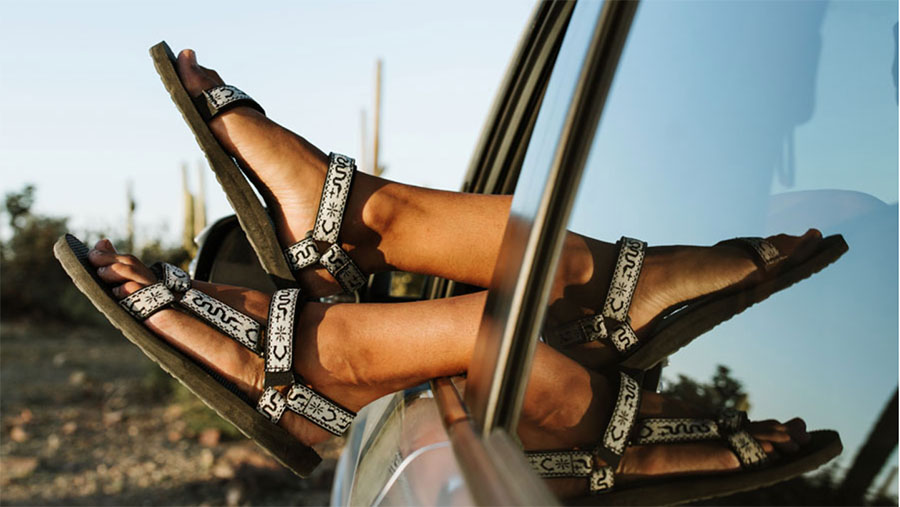Deckers Brands, home to the Hoka, Ugg, Teva, Sanuk, and Koolaburra, brands, saw fourth-quarter revenue come in at $791.6 million, representing an increase of 7.5 percent versus the prior-year fourth quarter. Performance in the quarter was driven by continued momentum with Hoka, including the brand nearly doubling last year’s DTC (direct-to-consumer) revenue as well as strength in Teva as the brand recaptured revenue lost in the previous year due to supply chain disruption. The gains were partially offset by a reduction in Ugg revenue as the brand lapped abnormal wholesale shipping patterns in the prior-year quarter from pandemic-related supply chain issues and experienced more normalized DTC demand.
Hoka brand net sales increased 40.3 percent to $397.7 million in fiscal Q4, partially offset by Ugg brand net sales performance that decreased 16.1 percent to $314.3 million. Teva brand net sales increased 14.6 percent to $62.8 million in fiscal Q4, while Sanuk brand net sales decreased 10.5 percent to $10.7 million. Other brands net sales, primarily composed of Koolaburra, decreased 46.2 percent to $6.0 million to finish the fiscal year.
Gross margin in the fourth quarter was 50.3 percent of sales, a 130 basis point improvement from the prior-year period. The improved gross margin primarily relates to reduced air freight usage, favorable brand and channel mix from the strength of the Hoka DTC business and lower ocean freight rates, which were partially offset by increased promotional activity for Ugg as the brand sought to reduce inventory levels of non-core seasonal product and continued headwinds from unfavorable foreign currency exchange rates.
SG&A for the quarter was $290 million, representing 36.7 percent of revenue, which compares to last year’s $277 million and 37.7 percent of revenue. SG&A as a percentage of revenue was down year-over-year as DECK gained leverage on marketing, where they avoided spending in areas of overperformance.
These results, coupled with higher interest income and a lower share count as a result of their share repurchase program, drove diluted earnings per share increase of 95 cents, or 38 percent, to $3.46 a share for the quarter, which compares to $2.51 in the prior-year period.
In a bit of a surprising twist, Decker’s management spent more time on its quarterly conference call with analysts talking about full-year results rather than the most recent quarter. But the shift from “normal” year-end conversation can be more clearly understood when looking at the scope of what Hoka achieved over a 12-month period.
“For fiscal year 2023, our brands achieved revenue growth of 15 percent on a reported basis versus the prior year to more than $3.6 billion, which is 42 percent and $1.1 billion above revenue of 2 years ago,” outlined company President and CEO Dave Powers on the call. “Operating margin in line with the high-end of our guidance range at 18 percent, which is top tier in our industry and a more than $3 increase in earnings per share representing a 19 percent increase versus last year.
“Specifically,” Powers continued, “our progress in fiscal year 2023 includes Hoka driving global revenue growth of 58 percent versus last year to eclipse $1.4 billion; Ugg revenue holding steady in constant currency with the brand increasing its mix of both direct-to-consumer and international business; global portfolio DTC adding more than $0.25 billion of incremental revenue, growing at nearly twice the rate of wholesale; and our international markets increasing 20 percent versus the prior year on a reported basis, which when accounting for an approximate $100 million headwind from currency fluctuations, increased 30 percent in constant currency.
“Reflecting on the past few years, our company’s performance is remarkable, particularly given the consumer climate and speed with which we have had to build our infrastructure to support this incredible growth. We still have much more work ahead to build upon the foundation for long-term sustainable growth, but I am truly proud of how far we have come. We believe that the strength of our operations, omnichannel management and brand teams have enabled our organization to improve resilient and capable of achieving the goals we have set forth, including driving significant top-line growth, while maintaining an 18 percent operating margin and reducing inventories to more appropriate levels,” Powers concluded in his opening remarks.
Global Hoka revenue for fiscal year 2023 increased 58.5 percent, or $521 million, versus the prior fiscal year to $1.41 billion, the fourth consecutive year Hoka has delivered revenue growth above 50 percent. Let that sink in; $521 million in additional annual revenue – for a running brand. Hoka’s growth for the year was said to be driven by a more than 30 percent increase in global brand awareness in fall 2022; an acceleration of DTC, which grew 85 percent versus the prior year; broader category adoption; market share growth with existing points of wholesale distribution; and additional access points with the brand’s strategic partners, which was complemented by the increased availability of product inventory and an improved supply chain environment.
Powers said the Hoka brand’s momentum helped drive a 5 percentage point increase in DTC mix up to 34 percent of total brand revenue as compared to 29 percent in the prior fiscal year. He said Hoka continues to bring new consumers into the brand, while also retaining existing consumers, evidenced by a 78 percent increase in acquisition and an 81 percent increase in retention as compared to the prior year.
Among DTC purchasers in the U.S. and EMEA, multi-category purchases reportedly increased 79 percent and 127 percent versus last year, respectively. Across all channels, Hoka more than doubled revenue on trail and hike products aided by the Speedgoat and Challenger updates as well as market share gains with the Kaha and Anacapa franchises and fitness and recovery products benefiting from greater over-recovery sandal adoption and introduction of both the Solimar and Transport Styles.
Hoka’s full-year wholesale revenue increased 47 percent versus the prior fiscal year, driven by market share gains with existing points of distribution, which accounted for approximately two-thirds of global dollar growth, and additional access points with strategic partners. Powers said Hoka continues to prioritize delivering a pinnacle experience with performance products with the brand’s run and outdoor specialty partners while expanding the addressable market through strategic relationships that broaden brand awareness beyond the traditional specialty consumer.
“With expanded distribution, Hoka is placing greater emphasis on the segmentation to align product and marketing with the respective distribution partners’ target consumer,” Powers said. “Hoka is leveraging the run and outdoor specialty channel to maintain authenticity and brand credibility by offering exclusive high-performance products that are only available at DTC and select specialty doors.”
Powers said marketplace management continues to be a top priority for Hoka as the brand enters fiscal year 2024.
“At the current scale north of $1.4 billion, our focus is to protect the Hoka brand’s premium positioning and maintain a pull model,” he offered. “Hoka plans to emphasize growth in the DTC channel, driving high full-price sell-through and building market share with existing points of wholesale distribution, especially in light of a dynamic consumer environment.”
Powers said the focus on marketplace management will be particularly evident in their EMEA region as Hoka expects to prioritize low levels of promotion in the coming year.
Ugg global revenue for fiscal year 2023 was $1.93 billion, which is down 2.7 percent versus the prior fiscal year on a reported basis, but up slightly in constant-currency terms. Powers said Ugg performed in line with expectations as the brand focused on driving growth through DTC and international markets while facing tough comparisons from the prior fiscal year related to refilling domestic wholesale inventories as well as currency exchange rate pressures overseas.
Despite these unique dynamics, Ugg reportedly maintained high levels of brand heat and demand, as evidenced by the strength of global DTC acquisition and retention, which increased 16 percent and 15 percent versus the prior fiscal year, respectively.
“While this is a tremendous growth figure in terms of worldwide consumers, we have been even more encouraged by the trends in our international markets, where the acquisition was up 29 percent and retention increased 37 percent over the prior year,” Powers commented.
EMEA was said to be the fastest-growing DTC region across the globe for Ugg, aided by an 80 percent increase in new visitors to Ugg.com in Europe. Helping drive the buzz around Ugg, the brand was featured in a number of highly respected fashion publications, with each touting the brand’s fashion relevance.
“The Ugg team has done an excellent job executing a brand-appropriate collaboration strategy over the past few years, which continues to benefit awareness and increase visibility with target consumers,” Powers said.
Powers said search interest for the Ugg brand in the U.S. increased 26 percent versus last year, according to Google Trends.
The CEO said Ugg delivered a fantastic result for the year given the challenges it faced, both in terms of comparing to abnormal shipping timing and volumes and impacts from currency headwinds.
“The Ugg team is developing compelling products through the integration of consumer data and insights within each layer of the product creation process,” he concluded. “We are excited for the year ahead as the brand continues to build on the international opportunity and maintain the exciting momentum of the last few years.”
Teva brand global revenue for fiscal year 2023 increased 12.5 percent versus last year to a record $183.1 million. This is the second consecutive year of double-digit growth for Teva as the brand continues to be “a leader in the sports sandal category with aspirations to become a destination brand for the modern outdoor consumer.”
Turning to channel performance, Powers said that fiscal year 2023 results were driven by strength across the direct-to-consumer and wholesale businesses, “both of which drove more than $200 million of incremental revenue.”
For the year, DTC revenue on a reported basis increased 20.8 percent to $1.47 billion, representing 40 percent of consolidated revenue. On a DTC comparable basis, revenue increased 23 percent versus last year, with healthy growth in both the physical and digital segments.
“Gains in our direct-to-consumer business were driven by the continued momentum of global consumer acquisition and retention, which increased 28 percent and 29 percent, respectively, versus last year,” Powers shared. “We are encouraged that all major regions drove double-digit DTC growth in reported dollars, especially considering the significance of currency headwinds in our international markets.”
Wholesale channel revenue increased 11.6 percent to $2.16 billion on a reported basis versus the prior fiscal year, which primarily reflects global market share gains for the Hoka brand, which was partially offset by a reduction of Ugg domestic wholesale revenue as the company did not repeat the fill-in activity that occurred in fiscal year 2022.
“The success we are seeing with both DTC and wholesale is a testament to our omnichannel brand and marketplace management,” Powers said. “Maintaining the authentic and premium positioning of our brands in their respective markets continues to be our top priority, especially as we navigate an ongoing dynamic consumer environment.”
Deckers Brands consolidated gross margin for the year was 50.3 percent of sales, down 70 basis points versus the prior fiscal year. The decrease in gross margin was said to be primarily related to “unfavorable foreign currency exchange rates, higher levels of promotion and lower-margin closeouts, entire ocean freight rates in the first half with positive offsets from reduced levels of air freight, a greater mix of Hoka brand revenue including benefits from price increases and an increased mix of DTC business.”
SG&A dollar spend for the year was $1.17 billion, up 12.5 percent versus the prior year’s $1.04 billion level. SG&A represented 32.3 percent of revenue for the year, which was 80 basis points below the prior fiscal year. SG&A leverage as compared to last year was said to be driven primarily by lower marketing spend as a percentage of revenue as Deckers reduced spending in areas where inventory was short to help offset currency headwinds and delayed some spend targeted to build awareness.
This resulted in a full fiscal year 2023 operating margin of 18 percent, which is 10 basis points above the prior fiscal year, “despite significant currency headwinds.” Taxes were reportedly higher for the year, primarily as a result of changes in the jurisdictional mix of business.
“Our strong performance, along with higher interest income and a lower share count that resulted from share repurchase, culminated in a record diluted earnings per share of $19.37, which represents a 19 percent increase over last year’s $16.26,” stated company CFO Steve Fasching on the call.
DECK ended the fiscal year on March 31 with $982 million of cash and equivalents. Inventory was $533 million at year-end, up 5 percent versus the prior year-end. The company had no outstanding borrowings.
Looking ahead, Deckers is forecasting top-line revenue of approximately $3.95 billion for full fiscal year 2024, representing growth of approximately 9 percent versus the prior year, with Hoka as the main growth engine once again.
Hoka has seen increasing revenues in the range of 20 percent versus the prior year as they prioritize marketplace management. The majority of the Hoka growth is expected in the brand’s DTC channel with wholesale growth expectations assuming no net new doors added globally.
Ugg is forecast to increase revenues in the low-single-digits for fiscal 2024, driven by international expansion and a relatively flat U.S. marketplace as the brand focuses on driving the full-price business by maintaining the brand’s pull model. DTC growth is expected to once again outpace wholesale as the company drives consumer acquisition and retention, margin improvement and prioritized marketplace management.
Consolidated company gross margin is expected to be approximately 52 percent, which is more than 150 basis points above last year as Deckers anticipates “favorability from increasing DTC mix, increasing Hoka mix, with slight offsets from promotions,” which management expects to be higher than last year as they anticipate a consumer environment that may have greater uncertainty.
“Currency and freight are expected to be slight net tailwinds to our gross margin for the full fiscal year, but we expect to see headwind and tailwind fluctuations between quarters when compared to last year,” said Fasching. “SG&A is expected to be approximately 34 percent of revenue as we reinvest gross margin improvements in key areas of the business, which include talent across the organization, including areas we’ve delayed in the enterprise, supply chain footprint to match the growing scale of our organization, e-commerce capabilities and strategic marketing, which includes Hoka spend to grow awareness in leading international markets. Through the reinvestment of gross margin improvements into critical operating expense areas, we expect to maintain an approximate 18 percent operating margin in-line with what we’ve delivered in fiscal year 2023. We are projecting an effective tax rate of 22 percent to 23 percent. This all results in expected diluted earnings per share in the range of $21.10 to $21.60.”
Capital expenditures are expected to be in the range of $110 million to $120 million for the year.
However, given we are halfway through the first quarter, we wanted to provide some context around our expectations for the quarter ending June 30.
For the fiscal first quarter ended June 30, DECK sees revenue growth slightly below the 9 percent full fiscal year guidance as Ugg is not expected to repeat the early U.S. wholesale shipments that the brand experienced over the last couple of years during the first quarter and Hoka international wholesale growth is anticipated to be slower due to not repeating the earlier distributor shipments that occurred in last year’s first quarter.
Gross margin for Q1 is expected to be similar to the full fiscal year guided rate and SG&A dollar growth is planned to be up double digits as the company anticipates significant deleverage in the first quarter due to the phasing of certain investments.
“To summarize, we plan to grow DTC faster than wholesale as we prioritize marketplace management and direct-to-consumer acquisition, focus on Ugg products with recognizable brand codes to feed the global momentum with young consumers, continue to manage inventory to align with our consumer demand and invest behind key strategies and infrastructure to further bolster our organization to support our scaling business,” Powers concluded.
For more details on the Hoka and Ugg businesses in fiscal 2023, read these SGB Executive articles:
EXEC: Hoka Added $521 Million In New Revenue In Fiscal 2023; DTC Remains Focus
EXEC: Ugg Brand Looks To Europe And DTC For Growth After Fiscal 2023 U.S. Weakness
Photo courtesy Deckers Brands
















